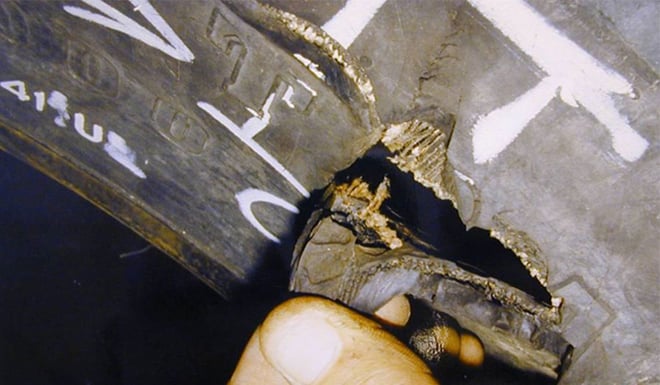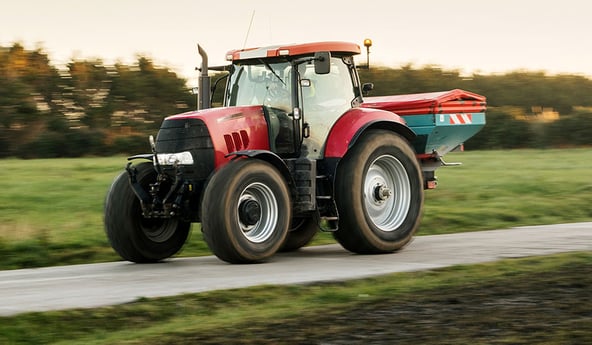Farming tyres are becoming increasingly technological, specialising to meet the specific needs of each of your activities. Whether you are driving a lot on the roads between your fields, transporting your harvest, working in the farmyard or mainly in the fields, your tyres need to perform properly however you use them.
Regular inspection of your farm tyres will help you to maintain them, and limit wear and tear, prolonging their lifespan to save you several thousands of euros.
In the field: tyres must be capable of working in low pressure with a high tractive force to save time and protect your soil.
For deforestation: they must be reinforced to avoid the risk of splits resulting from knocks, stones, roots, or branches.
In the farmyard: they need to be versatile to stand up to the many demands put on them and to avoid any potential splits.
On the road: they must be precise in bends, reliable when braking and ensure the comfort of the driver.
Many years of R&D ohave made it possible to improve the performance of tyres and their adaptation to all types of terrain. However, tyres are composed of many different materials, some of which are overlaid in layers, and which must remain united for the tyre to maintain its initial integrity, pressure, and performance level.
If the tyre is split or perforated during your work, it can no longer guarantee your safety and carry out the activities for which it was intended. You need to consider the risk of your tractor being completely immobilised without warning, which could cost a lot more than the price of simply changing your damaged tyre.
Before making a decision, you need to distinguish between superficial cuts or perforations and more serious splits which would make the tyre unsafe to use. In many cases it makes more sense to replace the damaged tyre completely rather than risking immobilising your tractor when you least expect it.
Here are 4 types of splits or perforations which cannot be repaired:
1. Splits in the tyre sidewall
Even when you take great care of your farming tyres by adapting the pressure to suit each activity, there will always be a risk of cuts or perforations.
This damage can often be superficial and linked to normal use of a tractor on various ground surfaces and for diverse activities. While not necessarily serious, some damage such as tearing or splitting of the tyre sidewall may result in an immediate loss of pressure, obliging you to stop your activity to avoid the risk of aggravating the problem.
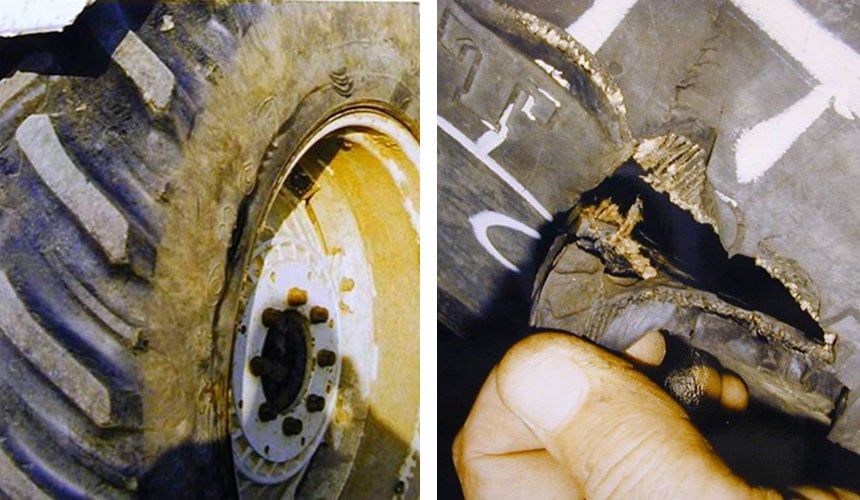 This type of cut may be caused by a sharp metal object (scrap iron, forgotten tool…), a root, a sharp branch, a piece of flint or any other debris.
This type of cut may be caused by a sharp metal object (scrap iron, forgotten tool…), a root, a sharp branch, a piece of flint or any other debris.
The tyre sidewall does not have the same level of reinforcement as the tread, making it much more vulnerable to any type of sharp or pointy object.
If the sidewall splits, even superficially, there is no point in trying to repair it as any patch would not last long and would peel off due to the repetitive distortions caused by the load carried. Any attempt to repair this zone is likely to weaken the entire tyre structure. It is best to replace the tyre.
However, it you think that it is possible to repair the tyre to save money, it is a bad idea to continue to drive on a tyre that is even slightly punctured. The pressure is what maintains the shape of the tyre while driving, and when the pressure is too low the sidewall will be pinched between the ground and the rim.
If you continue to drive in these conditions, you will increase the damage to the sidewall making it impossible to repair the tyre.
The best solution is to replace the damaged tyre on the spot.
2. Perforation in the tread
In contrast to certain parts like the sidewall, the tread is the most resistant element of the tyre. In high-quality low-pressure IF and VF tyres, the tread is designed with more layers of overlaid materials.
Despite this, the tyre cannot be repaired if the tread is perforated as the casing will also be perforated. There is a greatly increased risk of the tyre bursting and an accident could occur at any time in case of increased pressure or heating when driving on the road.
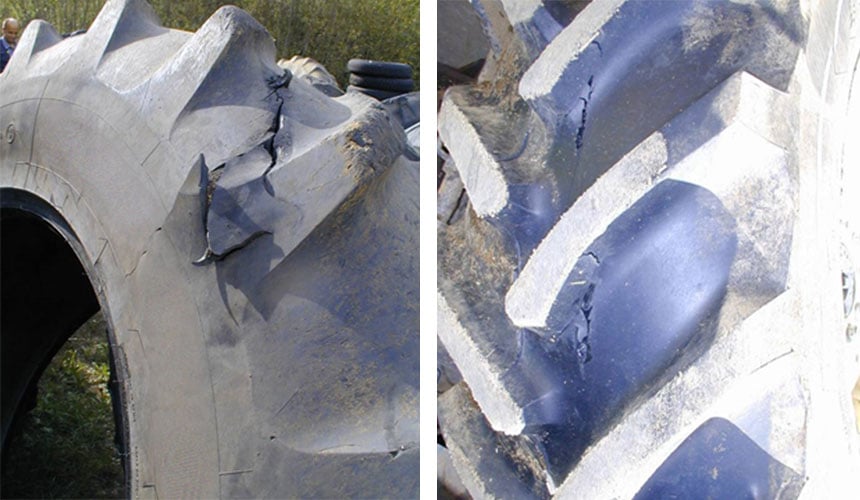 Besides any potential perforation, the tread can also become cracked in the same way as the sidewall. If these cracks are superficial and small, they are not particularly important. They are often due to the rubber ageing, to normal wear, or from a prolonged period of non-use. You can also sometimes see small superficial holes caused by the impacts of crop residues or stones.
Besides any potential perforation, the tread can also become cracked in the same way as the sidewall. If these cracks are superficial and small, they are not particularly important. They are often due to the rubber ageing, to normal wear, or from a prolonged period of non-use. You can also sometimes see small superficial holes caused by the impacts of crop residues or stones.
However, you must be attentive to any deeper cracks as they are a sure sign of damage to the tyre casing and can be a real threat to the safety of the driver. A small knock could cause the tyre to burst, it is best to replace the tyre quickly before beginning a new activity.
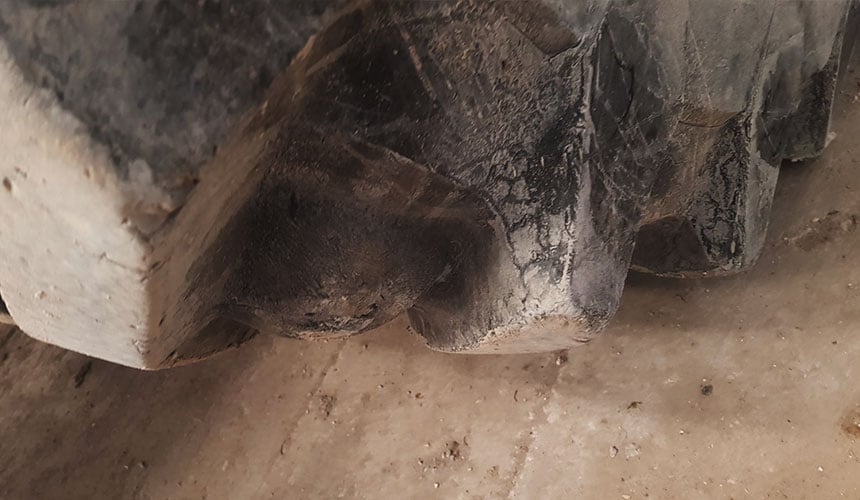
3. Split at the base of the rim
It is a good idea to reduce the pressure as much as possible to avoid compacting your fields, especially as high tyre pressure will have a negative impact on the soil and the root development of your crops.
But if you drive often with a heavy load and under inflated tyres, in particular on the road, there is a high risk of causing splits at the base of the rim. Frequent use at a low pressure will cause wear and progressive abrasion to the plies and to the casing reinforcements along the rim edge. This is due to the excessive movements and distortions of the sidewall.
In concrete terms, the split will occur along the casing plies, making it necessary to replace your farming tyres, as they will become beyond repair.
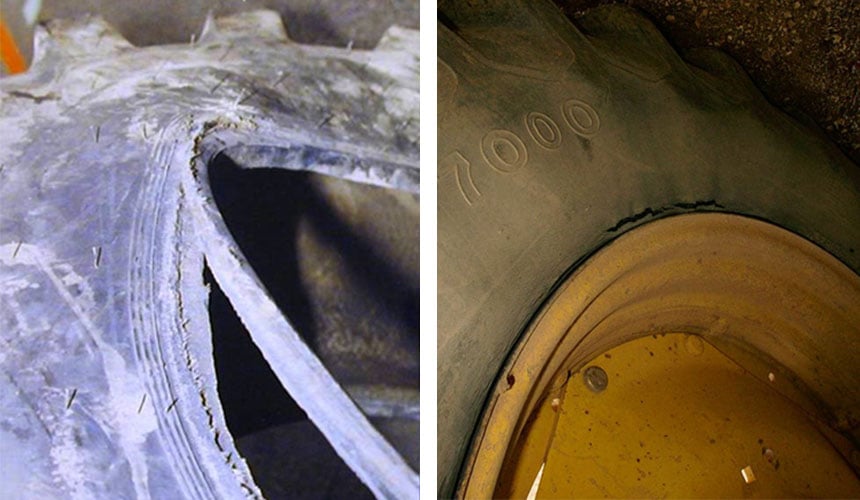 To avoid having to adjust your tyre pressure manually when switching from one surface to another, the most practical solution is to use IF (Increased Flexion) or VF (Very High Flexion) technology tyres which are designed for use at low pressure. With a reinforced radial structure, they are mounted on a specific framework and their sidewalls are more resistant and more flexible.
To avoid having to adjust your tyre pressure manually when switching from one surface to another, the most practical solution is to use IF (Increased Flexion) or VF (Very High Flexion) technology tyres which are designed for use at low pressure. With a reinforced radial structure, they are mounted on a specific framework and their sidewalls are more resistant and more flexible.
4. Split in the casing
In some cases, a split can occur in the casing which will usually require the replacement of your farming tyre. In general, the casing is composed of several layers of a woven structure which provides the tyre’s integrity, strength, and elasticity.
This can be cut or punctured after a full-on collision or after driving over a piece of metal, a sharp object, stone, root, branch, etc.
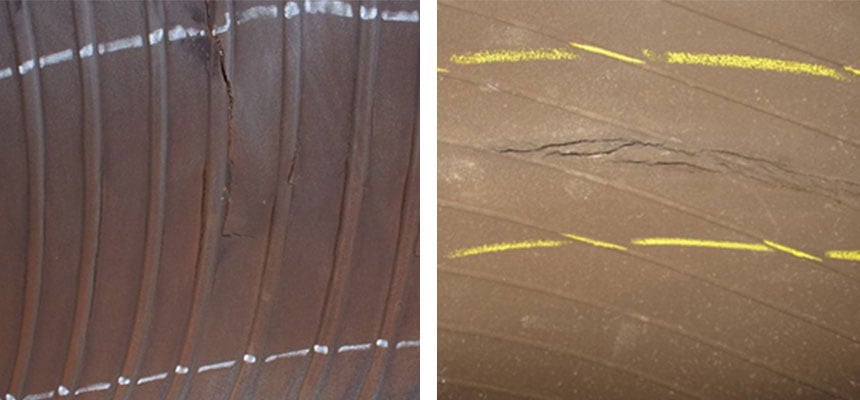 If the internal structure of the tyre is damaged, it becomes irreparable and unusable as it will not be able to cope with an increase in pressure. If you continue to drive on this damaged tyre, the weakened structure can cause it to explode at any time if it is overly distorted. You should change the tyre to avoid the risk of the it exploding on the road or puncturing in a field.
If the internal structure of the tyre is damaged, it becomes irreparable and unusable as it will not be able to cope with an increase in pressure. If you continue to drive on this damaged tyre, the weakened structure can cause it to explode at any time if it is overly distorted. You should change the tyre to avoid the risk of the it exploding on the road or puncturing in a field.
There are repairs and repairs
To save money, we often choose to repair splits in a tyre. However, some repairs are not effective, including on the spot repairs, in particular on the sidewalls which distort when you transport heavy loads for example. Even when driving in your fields, whether loaded or not, there is always a risk of the tyre bursting when you increase the pressure. Homemade or improvised repairs will not guarantee your safety.
A tyre exploding due to heating when driving at speed or when your machinery is loaded, could overturn your tractor, and being stuck in the middle of your field because the repair doesn’t hold will end up costing you much more than the price of a new tyre.
A tyre exploding due to heating when driving at speed or when your machinery is loaded, could overturn your tractor, and being stuck in the middle of your field because the repair doesn’t hold will end up costing you much more than the price of a new tyre.
To learn more about ways to increase your farm’s productivity, bridgestone-agriculture has created a comprehensive eBook on the topic which is available for you to download for free:
Bridgestone-agriculture Blog is written and administered by tractor tyre experts who are available to provide you with advice on agricultural tyres. They will help you to maximise your productivity with information on all things relating to tyres: inexpensive tractor tyres, technical data for agricultural tyres, solutions for avoiding soil compaction, sprayer tyre pressure, why and how to ballast your tractor tyres, when to use dual-wheels, the mechanical causes for abnormal wear, discounted agricultural tyres, etc...
Most people who read this article have also read some of the following articles:
This information is intended only to make you aware of the technical and functional aspects of agricultural tires and their use. It does not allow you to make a judgment or a definitive conclusion on a given problem. Only your agricultural tire expert is able to make a technical assessment and take a final decision, case by case.
Leave a
commentary
Your email address will not be published.
Required fields are indicated with *


